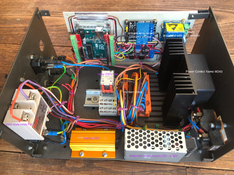I must admit, I can't really keep up with you guys. I am trying my best to make this work and learn everything I need along the way. (Excuse my stupid questions, I try my best to understand)
Here is what I was able (I think) to understand so far, as well as what I am going to do:
1) There are high currents that flow because of the low resistance that incandescent lights show when being cold.
2) These high currents (Higher than the lamp's rating) aren't too bad but can shorten the life of such a lamp.
3) I live in a part of Europe with 230v mains. I Would calculate the heat the resistor has to dissipate like this:
P= I^2 × R I= U/R I= 15/22 I= approx. 0,682 P=10,23W, does that mean my 100W resistor can be on for approx. 9,8sec? Or do I misunderstand?
4) What I have done so far: I purchased 1x 5V Power supply, 1x 24V Power supply, 2x ESP32s, a 5v 8chanel relay that can switch 230V, a high quality dimmer that can be controlled over PWM inputs, a normal 230v relay and a 100W 22ohm resistor.
5) My plan is to build the EST1000 substitute power supply as well as a simple timer unit. I will use the esp32 to control the shutter, the lamp and the cooling fan within my 1840 head. The timer will tell the “power supply” how many seconds it wants the exposure to be. The “power supply” will engage in the following tasks. (This is assuming the power supply was already turned on, and the idle temperature has already been reached. The resistor was switched in between the 15V idle for a couple of seconds.) The Esp will understand the timer input, let's say 7 seconds. It will then proceed to turn on the cooling fan over the 230V relay. After that, it will start up the lamp using the dimmer, going from “idle mode” to full strength “use mode”. The lamp now reaches its operating temperature and the shutter will be opened through the relay board. For exactly 7 seconds, that is. After that the shutter, obviously, closes again and the lamp gets put back into idle mode. The resistor only ever comes into play when the “power supply” is turned off and on.
This way I will have very accurate times, completely skipping the whole dilemma with interpreting the 230v mains relay inputs through a classical timer.
I can also configure my new timer in a way that allows me to use 1/16 - 1 Stop F stop increments, which I find terribly useful and a proper improvement over the old way. I am currently learning the C language to code the ESP32, I have no experience in any of this and am therefore a novice in everything.
6) Do you guys see any problems in my understanding of this, to me, it seems quite simple. Control Fan, shutter and the lamp. Am I mistaken?
7) If I program in a test strip mode, I will most likely let the lamp run over the full duration and just use the shutter in between.
Am I missing or overlooking anything crucial?
I thank you for your patience and help.





